LAWS20060 Taxation Law: Detailed Analysis and Application of Laws
VerifiedAdded on 2022/12/28
|21
|4006
|65
Report
AI Summary
This assignment provides a comprehensive analysis of various aspects of Australian taxation law. It addresses key areas such as the Commissioner's views on small business entities, deductions related to gifts and contributions, marginal tax rates, CGT assets, and the tax-free threshold. The assignment also differentiates between ordinary and statutory income, Medicare Levy and Medicare Levy Surcharge, and discusses the concepts of 'usual place of abode' and 'permanent place of abode' in determining residency. Furthermore, it evaluates the deductibility of various expenses, including HECS-HELP, travel, books, childcare, fridge repair, and clothing, referencing relevant sections of the Income Tax Assessment Act and case law. This document is available on Desklib, a platform offering study tools and solved assignments for students.
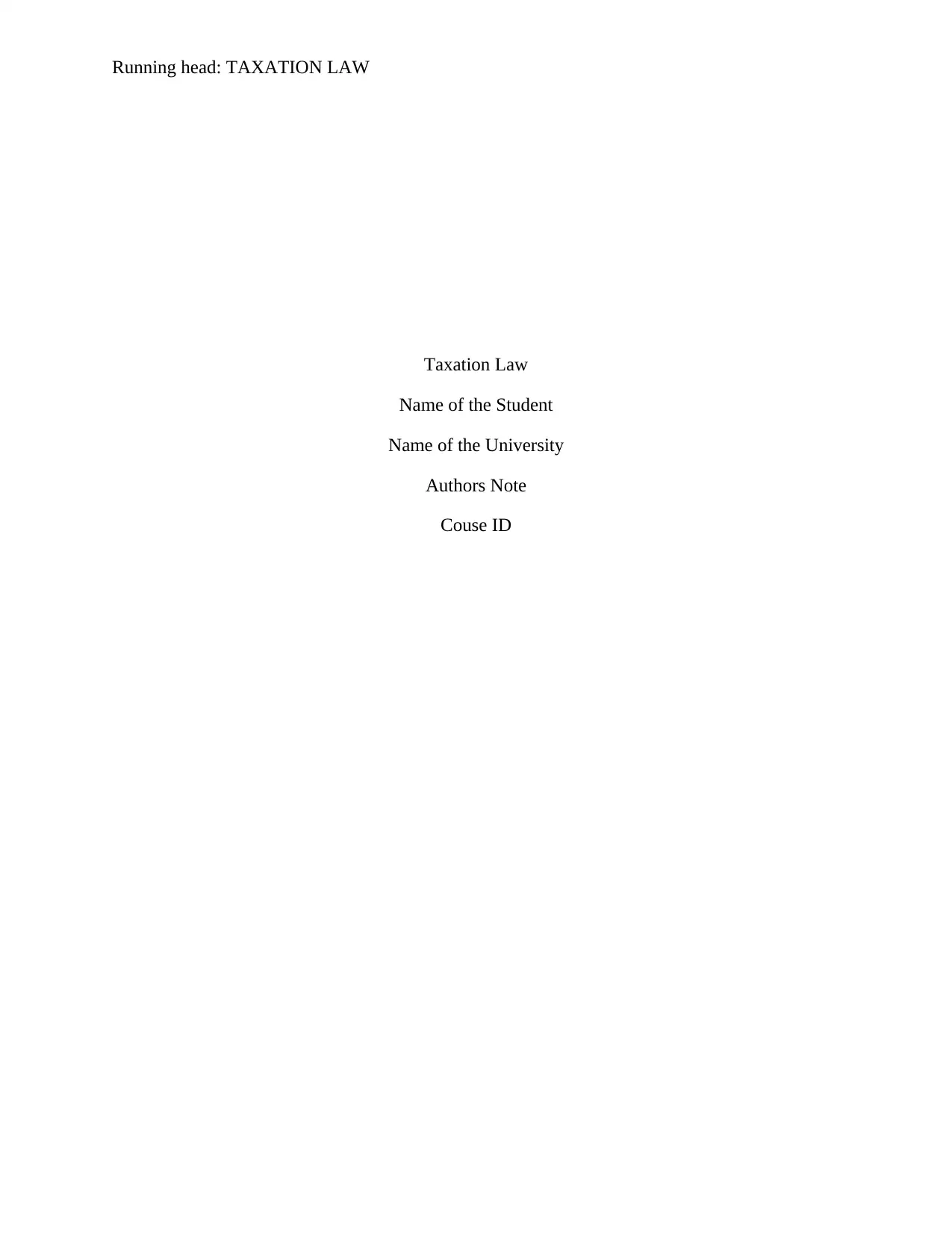
Running head: TAXATION LAW
Taxation Law
Name of the Student
Name of the University
Authors Note
Couse ID
Taxation Law
Name of the Student
Name of the University
Authors Note
Couse ID
Paraphrase This Document
Need a fresh take? Get an instant paraphrase of this document with our AI Paraphraser
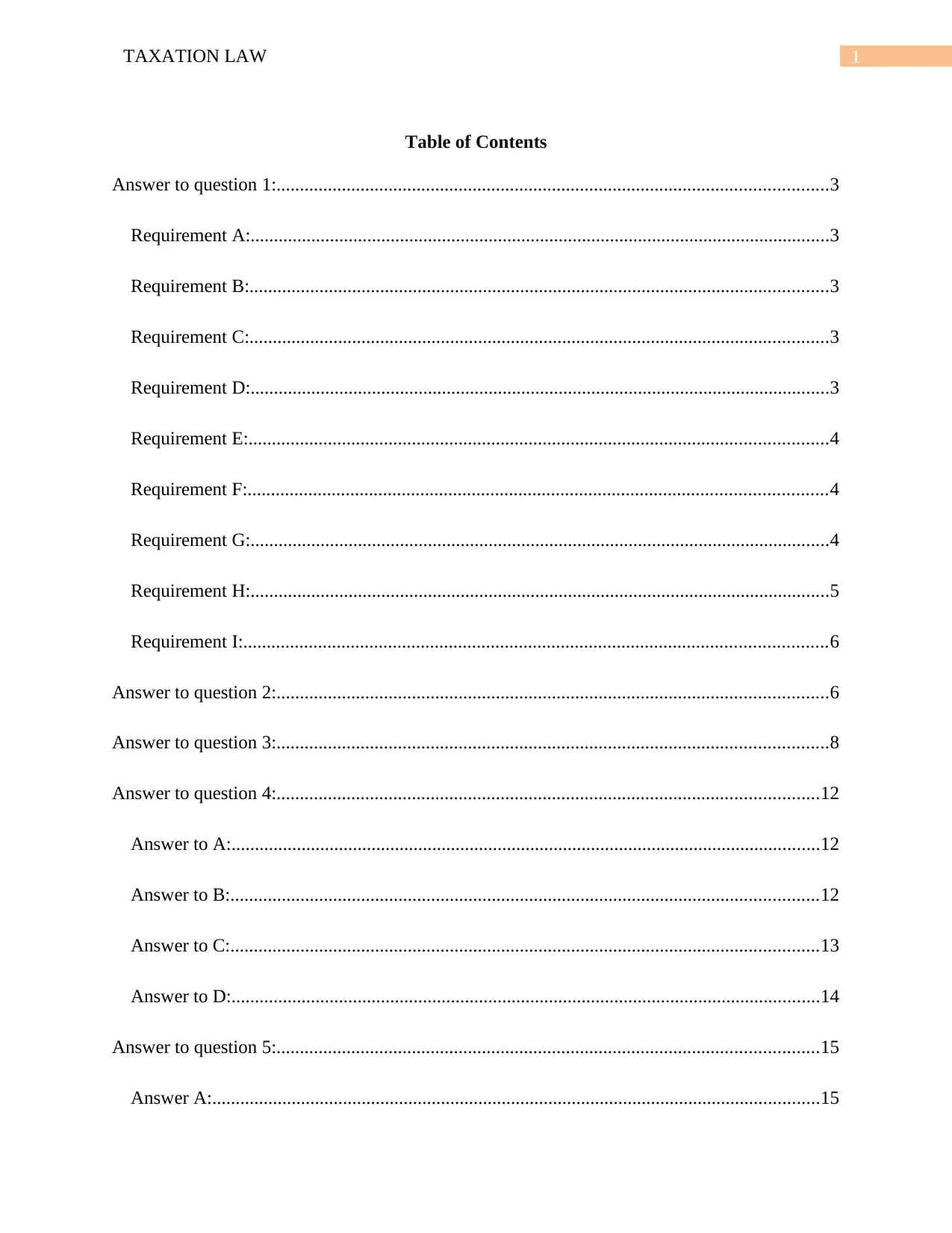
1TAXATION LAW
Table of Contents
Answer to question 1:......................................................................................................................3
Requirement A:............................................................................................................................3
Requirement B:............................................................................................................................3
Requirement C:............................................................................................................................3
Requirement D:............................................................................................................................3
Requirement E:............................................................................................................................4
Requirement F:............................................................................................................................4
Requirement G:............................................................................................................................4
Requirement H:............................................................................................................................5
Requirement I:.............................................................................................................................6
Answer to question 2:......................................................................................................................6
Answer to question 3:......................................................................................................................8
Answer to question 4:....................................................................................................................12
Answer to A:..............................................................................................................................12
Answer to B:..............................................................................................................................12
Answer to C:..............................................................................................................................13
Answer to D:..............................................................................................................................14
Answer to question 5:....................................................................................................................15
Answer A:..................................................................................................................................15
Table of Contents
Answer to question 1:......................................................................................................................3
Requirement A:............................................................................................................................3
Requirement B:............................................................................................................................3
Requirement C:............................................................................................................................3
Requirement D:............................................................................................................................3
Requirement E:............................................................................................................................4
Requirement F:............................................................................................................................4
Requirement G:............................................................................................................................4
Requirement H:............................................................................................................................5
Requirement I:.............................................................................................................................6
Answer to question 2:......................................................................................................................6
Answer to question 3:......................................................................................................................8
Answer to question 4:....................................................................................................................12
Answer to A:..............................................................................................................................12
Answer to B:..............................................................................................................................12
Answer to C:..............................................................................................................................13
Answer to D:..............................................................................................................................14
Answer to question 5:....................................................................................................................15
Answer A:..................................................................................................................................15
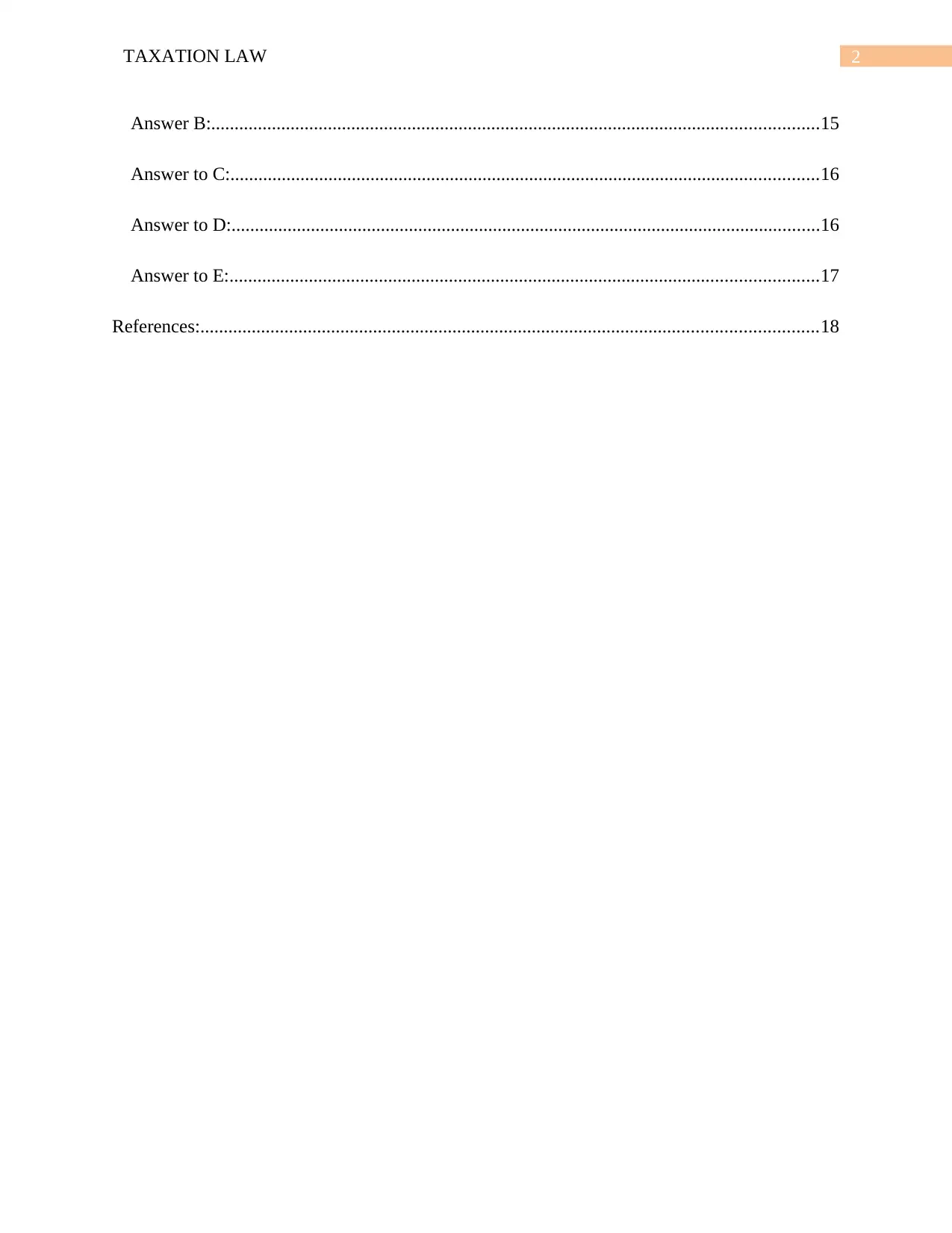
2TAXATION LAW
Answer B:..................................................................................................................................15
Answer to C:..............................................................................................................................16
Answer to D:..............................................................................................................................16
Answer to E:..............................................................................................................................17
References:....................................................................................................................................18
Answer B:..................................................................................................................................15
Answer to C:..............................................................................................................................16
Answer to D:..............................................................................................................................16
Answer to E:..............................................................................................................................17
References:....................................................................................................................................18
⊘ This is a preview!⊘
Do you want full access?
Subscribe today to unlock all pages.

Trusted by 1+ million students worldwide
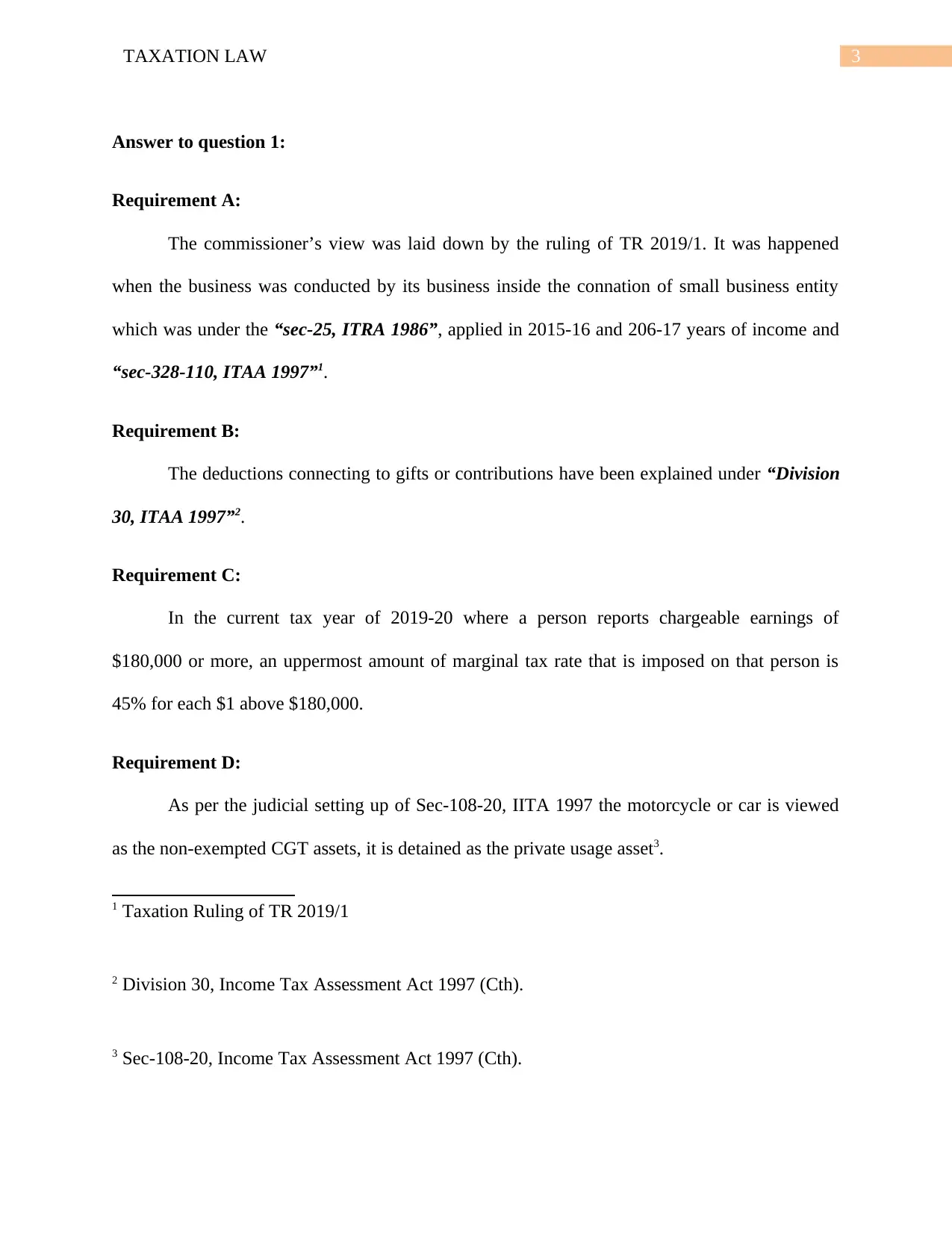
3TAXATION LAW
Answer to question 1:
Requirement A:
The commissioner’s view was laid down by the ruling of TR 2019/1. It was happened
when the business was conducted by its business inside the connation of small business entity
which was under the “sec-25, ITRA 1986”, applied in 2015-16 and 206-17 years of income and
“sec-328-110, ITAA 1997”1.
Requirement B:
The deductions connecting to gifts or contributions have been explained under “Division
30, ITAA 1997”2.
Requirement C:
In the current tax year of 2019-20 where a person reports chargeable earnings of
$180,000 or more, an uppermost amount of marginal tax rate that is imposed on that person is
45% for each $1 above $180,000.
Requirement D:
As per the judicial setting up of Sec-108-20, IITA 1997 the motorcycle or car is viewed
as the non-exempted CGT assets, it is detained as the private usage asset3.
1 Taxation Ruling of TR 2019/1
2 Division 30, Income Tax Assessment Act 1997 (Cth).
3 Sec-108-20, Income Tax Assessment Act 1997 (Cth).
Answer to question 1:
Requirement A:
The commissioner’s view was laid down by the ruling of TR 2019/1. It was happened
when the business was conducted by its business inside the connation of small business entity
which was under the “sec-25, ITRA 1986”, applied in 2015-16 and 206-17 years of income and
“sec-328-110, ITAA 1997”1.
Requirement B:
The deductions connecting to gifts or contributions have been explained under “Division
30, ITAA 1997”2.
Requirement C:
In the current tax year of 2019-20 where a person reports chargeable earnings of
$180,000 or more, an uppermost amount of marginal tax rate that is imposed on that person is
45% for each $1 above $180,000.
Requirement D:
As per the judicial setting up of Sec-108-20, IITA 1997 the motorcycle or car is viewed
as the non-exempted CGT assets, it is detained as the private usage asset3.
1 Taxation Ruling of TR 2019/1
2 Division 30, Income Tax Assessment Act 1997 (Cth).
3 Sec-108-20, Income Tax Assessment Act 1997 (Cth).
Paraphrase This Document
Need a fresh take? Get an instant paraphrase of this document with our AI Paraphraser
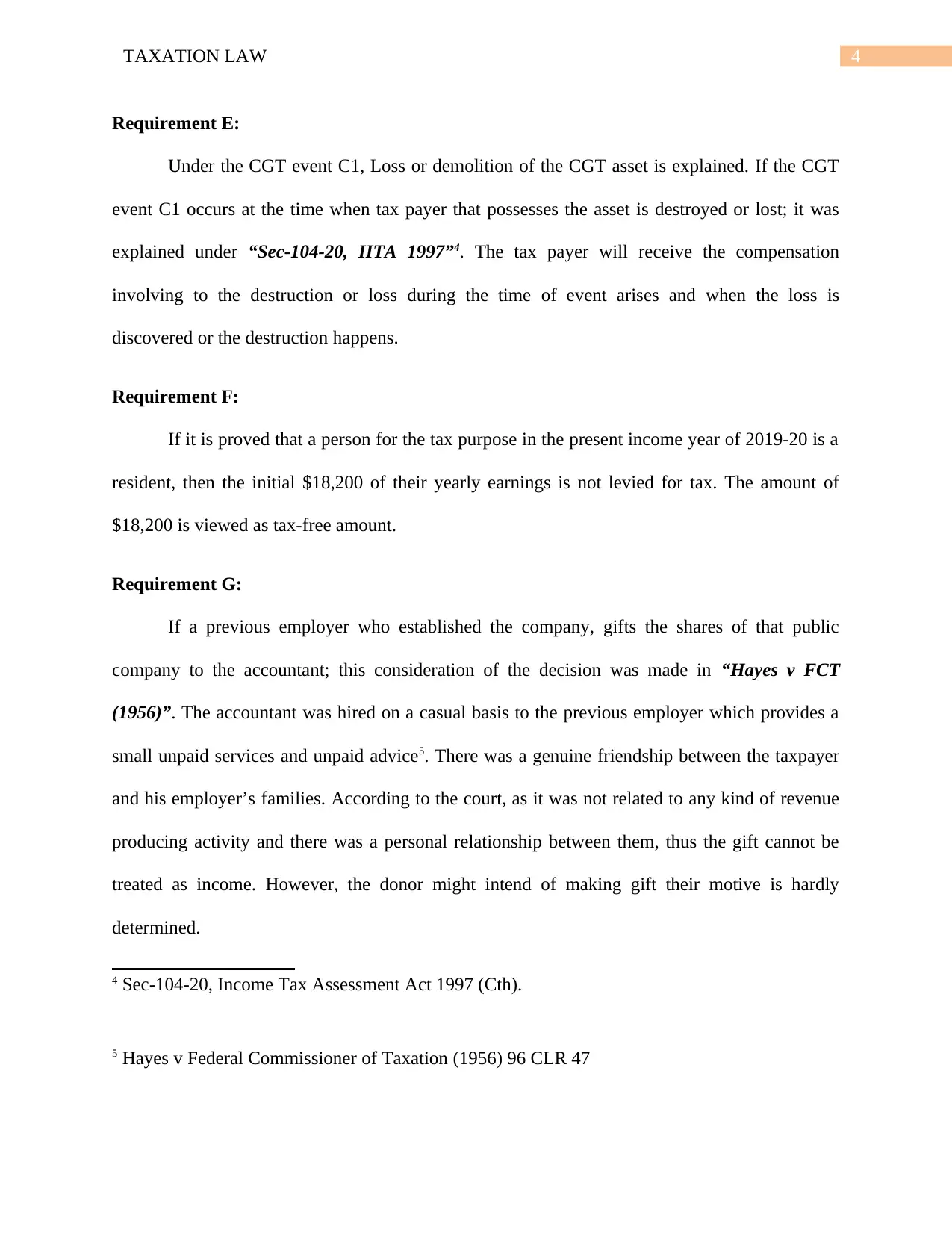
4TAXATION LAW
Requirement E:
Under the CGT event C1, Loss or demolition of the CGT asset is explained. If the CGT
event C1 occurs at the time when tax payer that possesses the asset is destroyed or lost; it was
explained under “Sec-104-20, IITA 1997”4. The tax payer will receive the compensation
involving to the destruction or loss during the time of event arises and when the loss is
discovered or the destruction happens.
Requirement F:
If it is proved that a person for the tax purpose in the present income year of 2019-20 is a
resident, then the initial $18,200 of their yearly earnings is not levied for tax. The amount of
$18,200 is viewed as tax-free amount.
Requirement G:
If a previous employer who established the company, gifts the shares of that public
company to the accountant; this consideration of the decision was made in “Hayes v FCT
(1956)”. The accountant was hired on a casual basis to the previous employer which provides a
small unpaid services and unpaid advice5. There was a genuine friendship between the taxpayer
and his employer’s families. According to the court, as it was not related to any kind of revenue
producing activity and there was a personal relationship between them, thus the gift cannot be
treated as income. However, the donor might intend of making gift their motive is hardly
determined.
4 Sec-104-20, Income Tax Assessment Act 1997 (Cth).
5 Hayes v Federal Commissioner of Taxation (1956) 96 CLR 47
Requirement E:
Under the CGT event C1, Loss or demolition of the CGT asset is explained. If the CGT
event C1 occurs at the time when tax payer that possesses the asset is destroyed or lost; it was
explained under “Sec-104-20, IITA 1997”4. The tax payer will receive the compensation
involving to the destruction or loss during the time of event arises and when the loss is
discovered or the destruction happens.
Requirement F:
If it is proved that a person for the tax purpose in the present income year of 2019-20 is a
resident, then the initial $18,200 of their yearly earnings is not levied for tax. The amount of
$18,200 is viewed as tax-free amount.
Requirement G:
If a previous employer who established the company, gifts the shares of that public
company to the accountant; this consideration of the decision was made in “Hayes v FCT
(1956)”. The accountant was hired on a casual basis to the previous employer which provides a
small unpaid services and unpaid advice5. There was a genuine friendship between the taxpayer
and his employer’s families. According to the court, as it was not related to any kind of revenue
producing activity and there was a personal relationship between them, thus the gift cannot be
treated as income. However, the donor might intend of making gift their motive is hardly
determined.
4 Sec-104-20, Income Tax Assessment Act 1997 (Cth).
5 Hayes v Federal Commissioner of Taxation (1956) 96 CLR 47
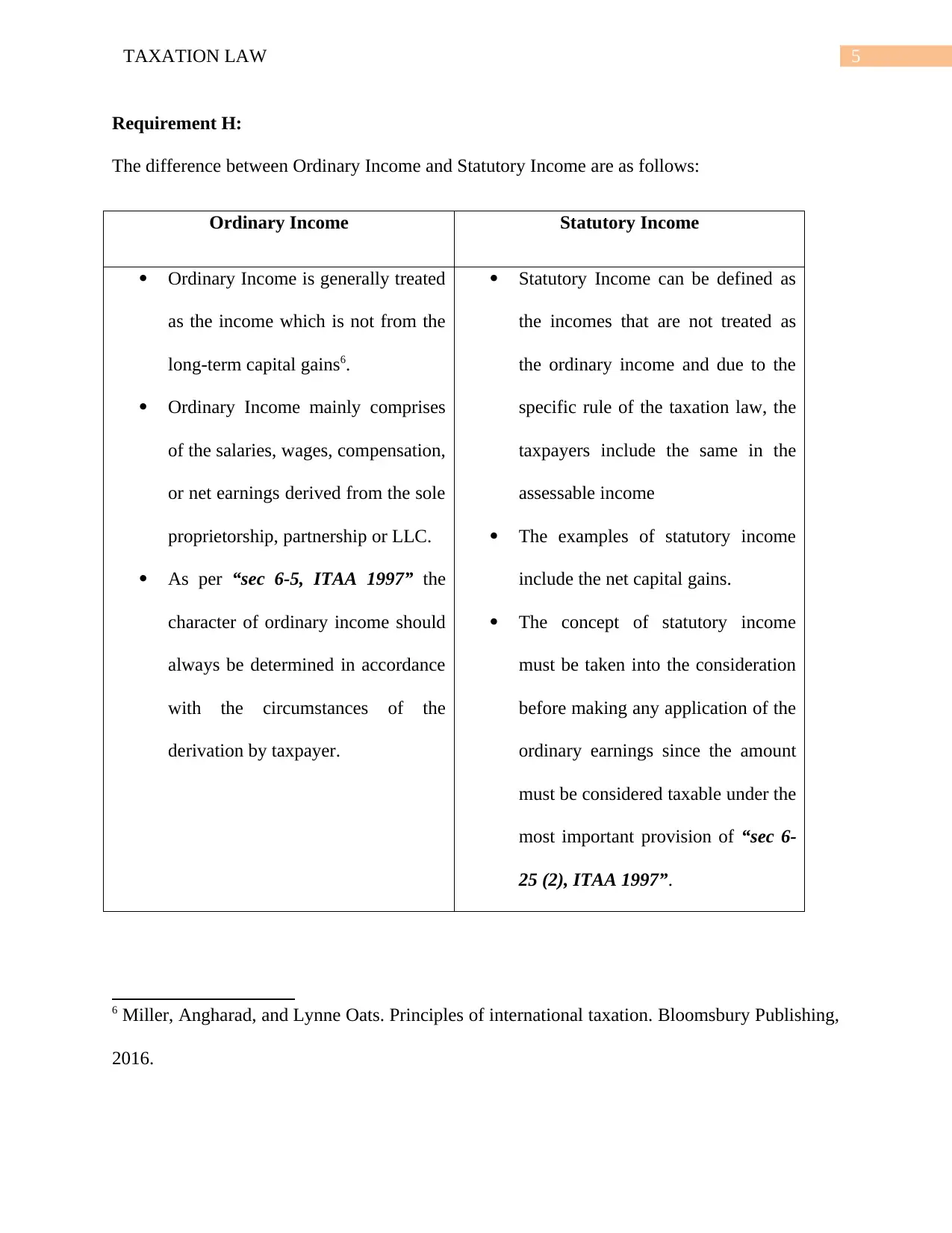
5TAXATION LAW
Requirement H:
The difference between Ordinary Income and Statutory Income are as follows:
Ordinary Income Statutory Income
Ordinary Income is generally treated
as the income which is not from the
long-term capital gains6.
Ordinary Income mainly comprises
of the salaries, wages, compensation,
or net earnings derived from the sole
proprietorship, partnership or LLC.
As per “sec 6-5, ITAA 1997” the
character of ordinary income should
always be determined in accordance
with the circumstances of the
derivation by taxpayer.
Statutory Income can be defined as
the incomes that are not treated as
the ordinary income and due to the
specific rule of the taxation law, the
taxpayers include the same in the
assessable income
The examples of statutory income
include the net capital gains.
The concept of statutory income
must be taken into the consideration
before making any application of the
ordinary earnings since the amount
must be considered taxable under the
most important provision of “sec 6-
25 (2), ITAA 1997”.
6 Miller, Angharad, and Lynne Oats. Principles of international taxation. Bloomsbury Publishing,
2016.
Requirement H:
The difference between Ordinary Income and Statutory Income are as follows:
Ordinary Income Statutory Income
Ordinary Income is generally treated
as the income which is not from the
long-term capital gains6.
Ordinary Income mainly comprises
of the salaries, wages, compensation,
or net earnings derived from the sole
proprietorship, partnership or LLC.
As per “sec 6-5, ITAA 1997” the
character of ordinary income should
always be determined in accordance
with the circumstances of the
derivation by taxpayer.
Statutory Income can be defined as
the incomes that are not treated as
the ordinary income and due to the
specific rule of the taxation law, the
taxpayers include the same in the
assessable income
The examples of statutory income
include the net capital gains.
The concept of statutory income
must be taken into the consideration
before making any application of the
ordinary earnings since the amount
must be considered taxable under the
most important provision of “sec 6-
25 (2), ITAA 1997”.
6 Miller, Angharad, and Lynne Oats. Principles of international taxation. Bloomsbury Publishing,
2016.
⊘ This is a preview!⊘
Do you want full access?
Subscribe today to unlock all pages.

Trusted by 1+ million students worldwide
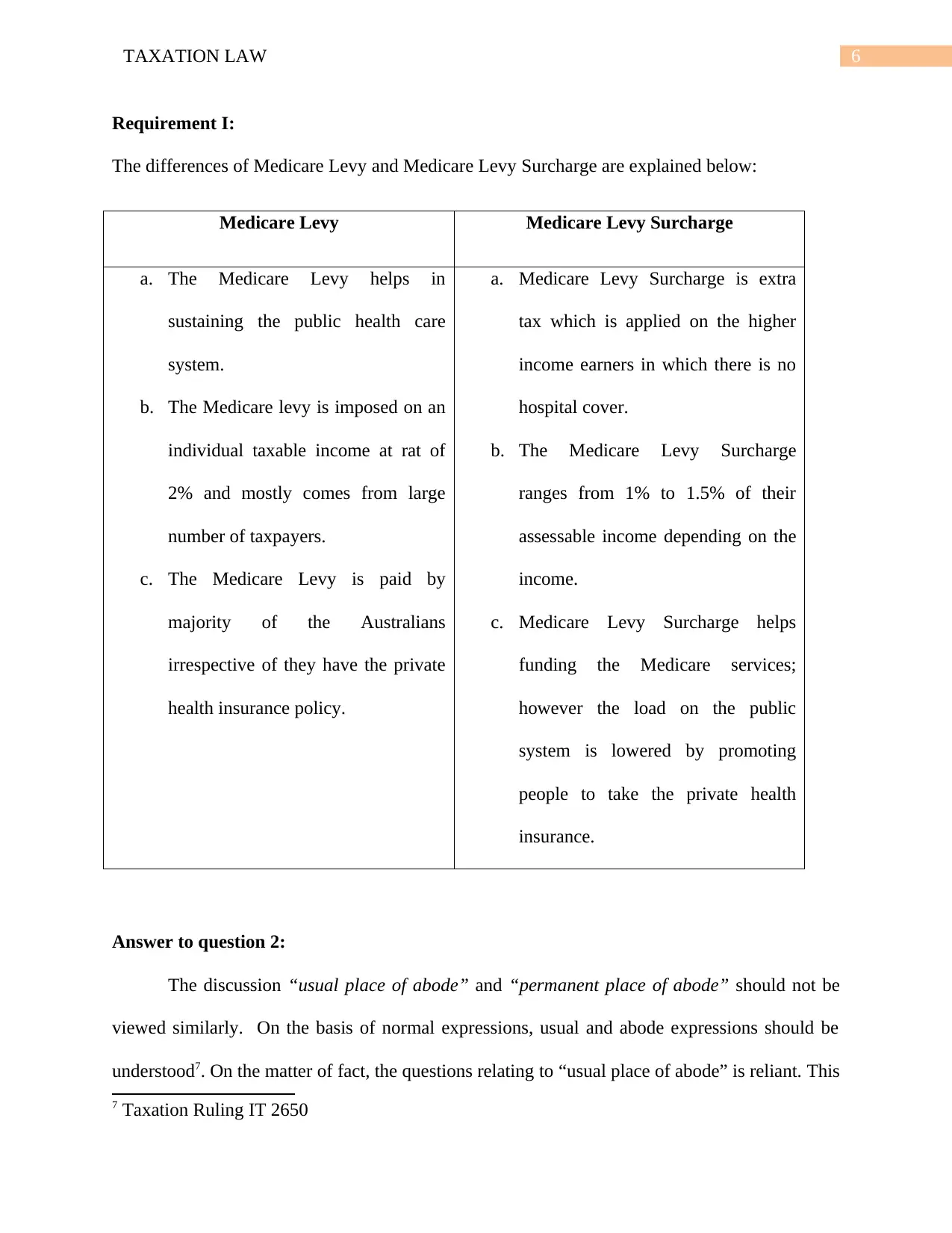
6TAXATION LAW
Requirement I:
The differences of Medicare Levy and Medicare Levy Surcharge are explained below:
Medicare Levy Medicare Levy Surcharge
a. The Medicare Levy helps in
sustaining the public health care
system.
b. The Medicare levy is imposed on an
individual taxable income at rat of
2% and mostly comes from large
number of taxpayers.
c. The Medicare Levy is paid by
majority of the Australians
irrespective of they have the private
health insurance policy.
a. Medicare Levy Surcharge is extra
tax which is applied on the higher
income earners in which there is no
hospital cover.
b. The Medicare Levy Surcharge
ranges from 1% to 1.5% of their
assessable income depending on the
income.
c. Medicare Levy Surcharge helps
funding the Medicare services;
however the load on the public
system is lowered by promoting
people to take the private health
insurance.
Answer to question 2:
The discussion “usual place of abode” and “permanent place of abode” should not be
viewed similarly. On the basis of normal expressions, usual and abode expressions should be
understood7. On the matter of fact, the questions relating to “usual place of abode” is reliant. This
7 Taxation Ruling IT 2650
Requirement I:
The differences of Medicare Levy and Medicare Levy Surcharge are explained below:
Medicare Levy Medicare Levy Surcharge
a. The Medicare Levy helps in
sustaining the public health care
system.
b. The Medicare levy is imposed on an
individual taxable income at rat of
2% and mostly comes from large
number of taxpayers.
c. The Medicare Levy is paid by
majority of the Australians
irrespective of they have the private
health insurance policy.
a. Medicare Levy Surcharge is extra
tax which is applied on the higher
income earners in which there is no
hospital cover.
b. The Medicare Levy Surcharge
ranges from 1% to 1.5% of their
assessable income depending on the
income.
c. Medicare Levy Surcharge helps
funding the Medicare services;
however the load on the public
system is lowered by promoting
people to take the private health
insurance.
Answer to question 2:
The discussion “usual place of abode” and “permanent place of abode” should not be
viewed similarly. On the basis of normal expressions, usual and abode expressions should be
understood7. On the matter of fact, the questions relating to “usual place of abode” is reliant. This
7 Taxation Ruling IT 2650
Paraphrase This Document
Need a fresh take? Get an instant paraphrase of this document with our AI Paraphraser
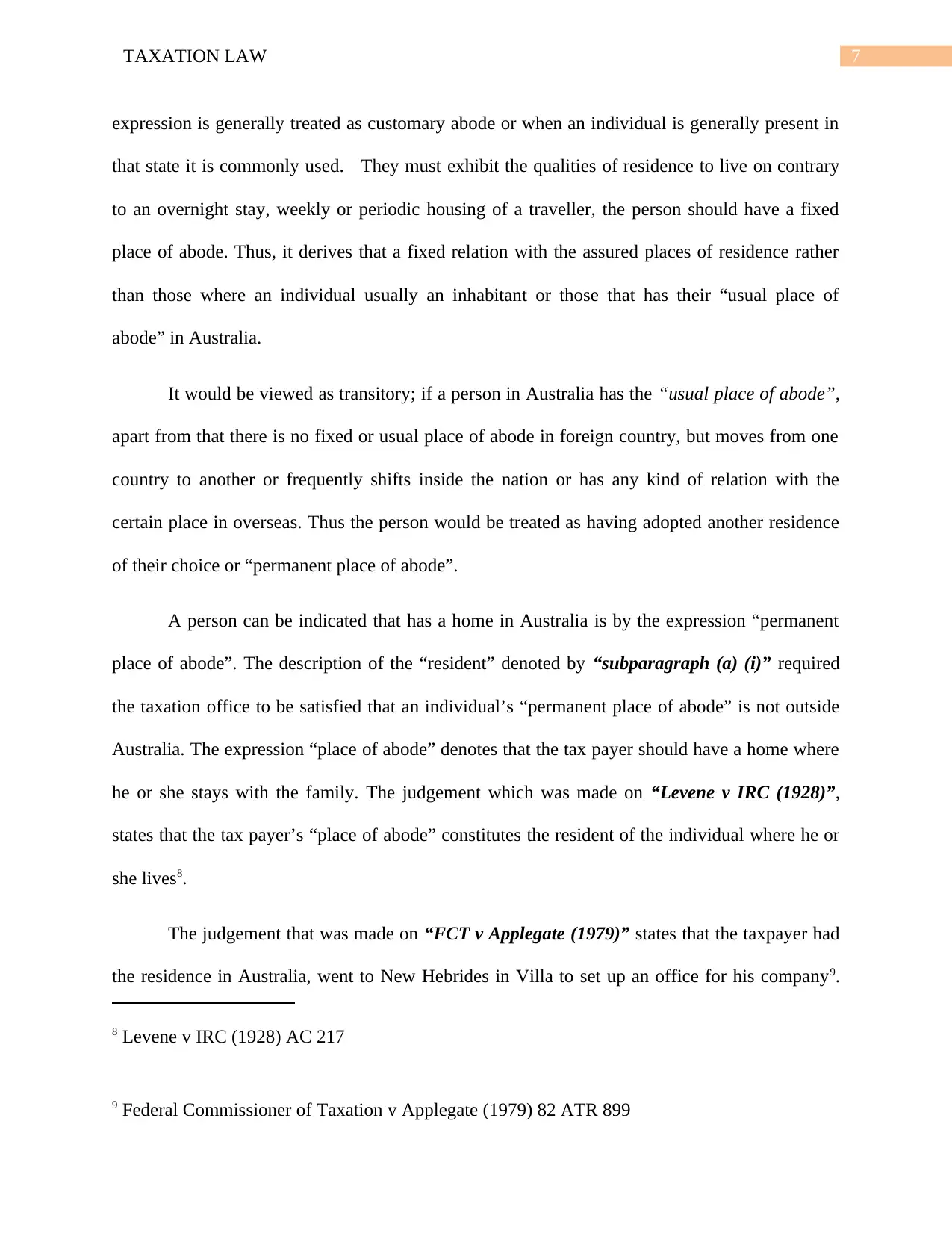
7TAXATION LAW
expression is generally treated as customary abode or when an individual is generally present in
that state it is commonly used. They must exhibit the qualities of residence to live on contrary
to an overnight stay, weekly or periodic housing of a traveller, the person should have a fixed
place of abode. Thus, it derives that a fixed relation with the assured places of residence rather
than those where an individual usually an inhabitant or those that has their “usual place of
abode” in Australia.
It would be viewed as transitory; if a person in Australia has the “usual place of abode”,
apart from that there is no fixed or usual place of abode in foreign country, but moves from one
country to another or frequently shifts inside the nation or has any kind of relation with the
certain place in overseas. Thus the person would be treated as having adopted another residence
of their choice or “permanent place of abode”.
A person can be indicated that has a home in Australia is by the expression “permanent
place of abode”. The description of the “resident” denoted by “subparagraph (a) (i)” required
the taxation office to be satisfied that an individual’s “permanent place of abode” is not outside
Australia. The expression “place of abode” denotes that the tax payer should have a home where
he or she stays with the family. The judgement which was made on “Levene v IRC (1928)”,
states that the tax payer’s “place of abode” constitutes the resident of the individual where he or
she lives8.
The judgement that was made on “FCT v Applegate (1979)” states that the taxpayer had
the residence in Australia, went to New Hebrides in Villa to set up an office for his company9.
8 Levene v IRC (1928) AC 217
9 Federal Commissioner of Taxation v Applegate (1979) 82 ATR 899
expression is generally treated as customary abode or when an individual is generally present in
that state it is commonly used. They must exhibit the qualities of residence to live on contrary
to an overnight stay, weekly or periodic housing of a traveller, the person should have a fixed
place of abode. Thus, it derives that a fixed relation with the assured places of residence rather
than those where an individual usually an inhabitant or those that has their “usual place of
abode” in Australia.
It would be viewed as transitory; if a person in Australia has the “usual place of abode”,
apart from that there is no fixed or usual place of abode in foreign country, but moves from one
country to another or frequently shifts inside the nation or has any kind of relation with the
certain place in overseas. Thus the person would be treated as having adopted another residence
of their choice or “permanent place of abode”.
A person can be indicated that has a home in Australia is by the expression “permanent
place of abode”. The description of the “resident” denoted by “subparagraph (a) (i)” required
the taxation office to be satisfied that an individual’s “permanent place of abode” is not outside
Australia. The expression “place of abode” denotes that the tax payer should have a home where
he or she stays with the family. The judgement which was made on “Levene v IRC (1928)”,
states that the tax payer’s “place of abode” constitutes the resident of the individual where he or
she lives8.
The judgement that was made on “FCT v Applegate (1979)” states that the taxpayer had
the residence in Australia, went to New Hebrides in Villa to set up an office for his company9.
8 Levene v IRC (1928) AC 217
9 Federal Commissioner of Taxation v Applegate (1979) 82 ATR 899
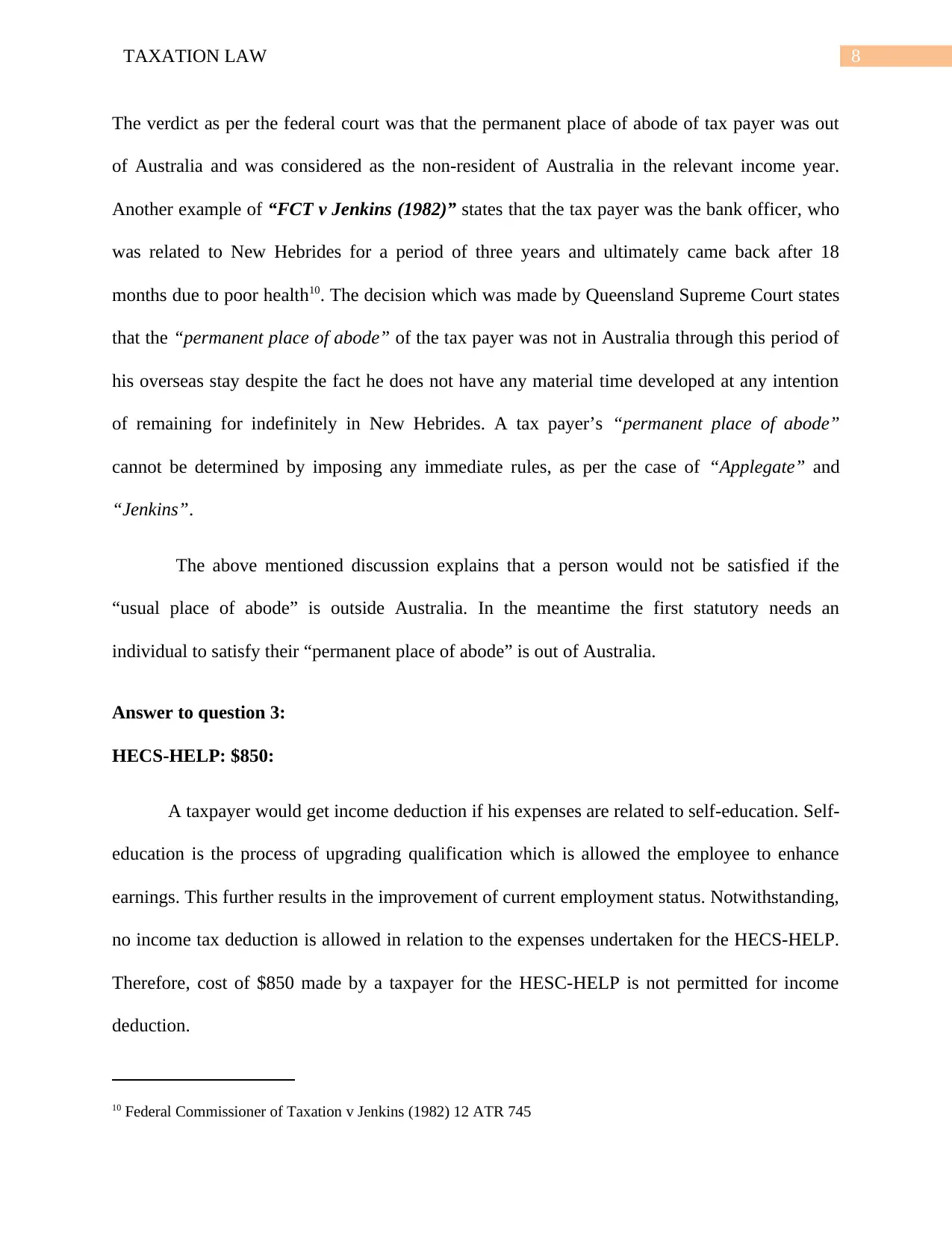
8TAXATION LAW
The verdict as per the federal court was that the permanent place of abode of tax payer was out
of Australia and was considered as the non-resident of Australia in the relevant income year.
Another example of “FCT v Jenkins (1982)” states that the tax payer was the bank officer, who
was related to New Hebrides for a period of three years and ultimately came back after 18
months due to poor health10. The decision which was made by Queensland Supreme Court states
that the “permanent place of abode” of the tax payer was not in Australia through this period of
his overseas stay despite the fact he does not have any material time developed at any intention
of remaining for indefinitely in New Hebrides. A tax payer’s “permanent place of abode”
cannot be determined by imposing any immediate rules, as per the case of “Applegate” and
“Jenkins”.
The above mentioned discussion explains that a person would not be satisfied if the
“usual place of abode” is outside Australia. In the meantime the first statutory needs an
individual to satisfy their “permanent place of abode” is out of Australia.
Answer to question 3:
HECS-HELP: $850:
A taxpayer would get income deduction if his expenses are related to self-education. Self-
education is the process of upgrading qualification which is allowed the employee to enhance
earnings. This further results in the improvement of current employment status. Notwithstanding,
no income tax deduction is allowed in relation to the expenses undertaken for the HECS-HELP.
Therefore, cost of $850 made by a taxpayer for the HESC-HELP is not permitted for income
deduction.
10 Federal Commissioner of Taxation v Jenkins (1982) 12 ATR 745
The verdict as per the federal court was that the permanent place of abode of tax payer was out
of Australia and was considered as the non-resident of Australia in the relevant income year.
Another example of “FCT v Jenkins (1982)” states that the tax payer was the bank officer, who
was related to New Hebrides for a period of three years and ultimately came back after 18
months due to poor health10. The decision which was made by Queensland Supreme Court states
that the “permanent place of abode” of the tax payer was not in Australia through this period of
his overseas stay despite the fact he does not have any material time developed at any intention
of remaining for indefinitely in New Hebrides. A tax payer’s “permanent place of abode”
cannot be determined by imposing any immediate rules, as per the case of “Applegate” and
“Jenkins”.
The above mentioned discussion explains that a person would not be satisfied if the
“usual place of abode” is outside Australia. In the meantime the first statutory needs an
individual to satisfy their “permanent place of abode” is out of Australia.
Answer to question 3:
HECS-HELP: $850:
A taxpayer would get income deduction if his expenses are related to self-education. Self-
education is the process of upgrading qualification which is allowed the employee to enhance
earnings. This further results in the improvement of current employment status. Notwithstanding,
no income tax deduction is allowed in relation to the expenses undertaken for the HECS-HELP.
Therefore, cost of $850 made by a taxpayer for the HESC-HELP is not permitted for income
deduction.
10 Federal Commissioner of Taxation v Jenkins (1982) 12 ATR 745
⊘ This is a preview!⊘
Do you want full access?
Subscribe today to unlock all pages.

Trusted by 1+ million students worldwide
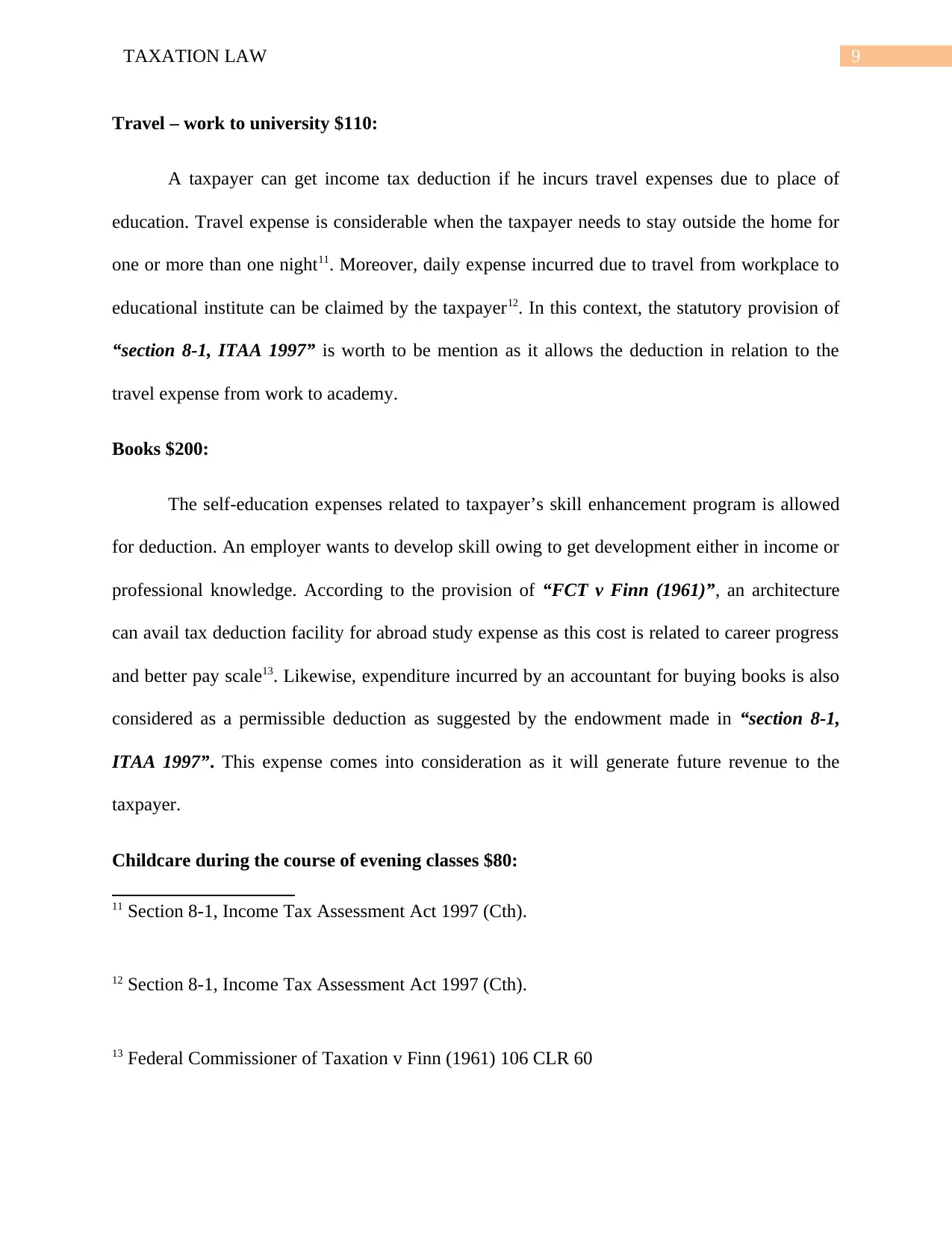
9TAXATION LAW
Travel – work to university $110:
A taxpayer can get income tax deduction if he incurs travel expenses due to place of
education. Travel expense is considerable when the taxpayer needs to stay outside the home for
one or more than one night11. Moreover, daily expense incurred due to travel from workplace to
educational institute can be claimed by the taxpayer12. In this context, the statutory provision of
“section 8-1, ITAA 1997” is worth to be mention as it allows the deduction in relation to the
travel expense from work to academy.
Books $200:
The self-education expenses related to taxpayer’s skill enhancement program is allowed
for deduction. An employer wants to develop skill owing to get development either in income or
professional knowledge. According to the provision of “FCT v Finn (1961)”, an architecture
can avail tax deduction facility for abroad study expense as this cost is related to career progress
and better pay scale13. Likewise, expenditure incurred by an accountant for buying books is also
considered as a permissible deduction as suggested by the endowment made in “section 8-1,
ITAA 1997”. This expense comes into consideration as it will generate future revenue to the
taxpayer.
Childcare during the course of evening classes $80:
11 Section 8-1, Income Tax Assessment Act 1997 (Cth).
12 Section 8-1, Income Tax Assessment Act 1997 (Cth).
13 Federal Commissioner of Taxation v Finn (1961) 106 CLR 60
Travel – work to university $110:
A taxpayer can get income tax deduction if he incurs travel expenses due to place of
education. Travel expense is considerable when the taxpayer needs to stay outside the home for
one or more than one night11. Moreover, daily expense incurred due to travel from workplace to
educational institute can be claimed by the taxpayer12. In this context, the statutory provision of
“section 8-1, ITAA 1997” is worth to be mention as it allows the deduction in relation to the
travel expense from work to academy.
Books $200:
The self-education expenses related to taxpayer’s skill enhancement program is allowed
for deduction. An employer wants to develop skill owing to get development either in income or
professional knowledge. According to the provision of “FCT v Finn (1961)”, an architecture
can avail tax deduction facility for abroad study expense as this cost is related to career progress
and better pay scale13. Likewise, expenditure incurred by an accountant for buying books is also
considered as a permissible deduction as suggested by the endowment made in “section 8-1,
ITAA 1997”. This expense comes into consideration as it will generate future revenue to the
taxpayer.
Childcare during the course of evening classes $80:
11 Section 8-1, Income Tax Assessment Act 1997 (Cth).
12 Section 8-1, Income Tax Assessment Act 1997 (Cth).
13 Federal Commissioner of Taxation v Finn (1961) 106 CLR 60
Paraphrase This Document
Need a fresh take? Get an instant paraphrase of this document with our AI Paraphraser
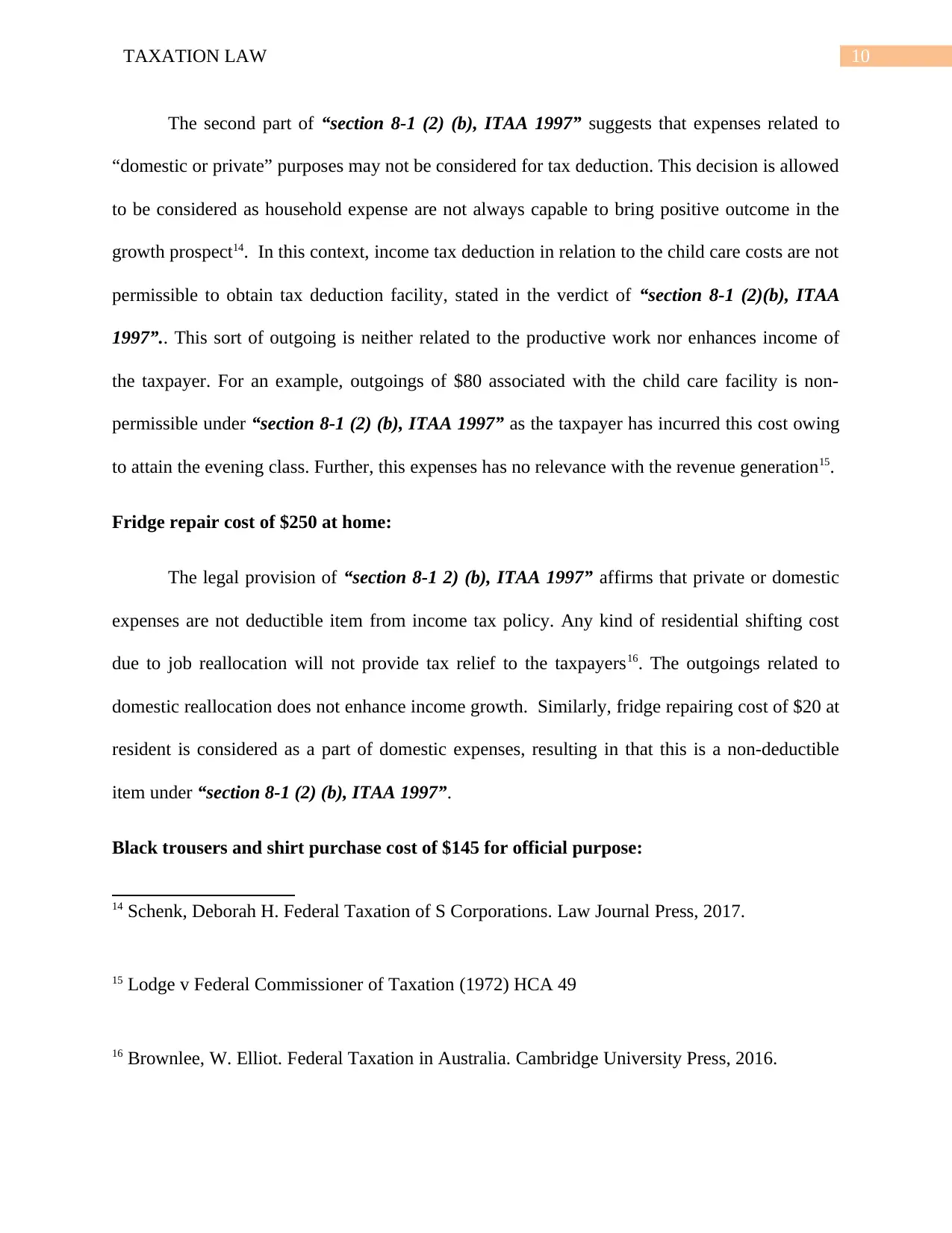
10TAXATION LAW
The second part of “section 8-1 (2) (b), ITAA 1997” suggests that expenses related to
“domestic or private” purposes may not be considered for tax deduction. This decision is allowed
to be considered as household expense are not always capable to bring positive outcome in the
growth prospect14. In this context, income tax deduction in relation to the child care costs are not
permissible to obtain tax deduction facility, stated in the verdict of “section 8-1 (2)(b), ITAA
1997”.. This sort of outgoing is neither related to the productive work nor enhances income of
the taxpayer. For an example, outgoings of $80 associated with the child care facility is non-
permissible under “section 8-1 (2) (b), ITAA 1997” as the taxpayer has incurred this cost owing
to attain the evening class. Further, this expenses has no relevance with the revenue generation15.
Fridge repair cost of $250 at home:
The legal provision of “section 8-1 2) (b), ITAA 1997” affirms that private or domestic
expenses are not deductible item from income tax policy. Any kind of residential shifting cost
due to job reallocation will not provide tax relief to the taxpayers16. The outgoings related to
domestic reallocation does not enhance income growth. Similarly, fridge repairing cost of $20 at
resident is considered as a part of domestic expenses, resulting in that this is a non-deductible
item under “section 8-1 (2) (b), ITAA 1997”.
Black trousers and shirt purchase cost of $145 for official purpose:
14 Schenk, Deborah H. Federal Taxation of S Corporations. Law Journal Press, 2017.
15 Lodge v Federal Commissioner of Taxation (1972) HCA 49
16 Brownlee, W. Elliot. Federal Taxation in Australia. Cambridge University Press, 2016.
The second part of “section 8-1 (2) (b), ITAA 1997” suggests that expenses related to
“domestic or private” purposes may not be considered for tax deduction. This decision is allowed
to be considered as household expense are not always capable to bring positive outcome in the
growth prospect14. In this context, income tax deduction in relation to the child care costs are not
permissible to obtain tax deduction facility, stated in the verdict of “section 8-1 (2)(b), ITAA
1997”.. This sort of outgoing is neither related to the productive work nor enhances income of
the taxpayer. For an example, outgoings of $80 associated with the child care facility is non-
permissible under “section 8-1 (2) (b), ITAA 1997” as the taxpayer has incurred this cost owing
to attain the evening class. Further, this expenses has no relevance with the revenue generation15.
Fridge repair cost of $250 at home:
The legal provision of “section 8-1 2) (b), ITAA 1997” affirms that private or domestic
expenses are not deductible item from income tax policy. Any kind of residential shifting cost
due to job reallocation will not provide tax relief to the taxpayers16. The outgoings related to
domestic reallocation does not enhance income growth. Similarly, fridge repairing cost of $20 at
resident is considered as a part of domestic expenses, resulting in that this is a non-deductible
item under “section 8-1 (2) (b), ITAA 1997”.
Black trousers and shirt purchase cost of $145 for official purpose:
14 Schenk, Deborah H. Federal Taxation of S Corporations. Law Journal Press, 2017.
15 Lodge v Federal Commissioner of Taxation (1972) HCA 49
16 Brownlee, W. Elliot. Federal Taxation in Australia. Cambridge University Press, 2016.
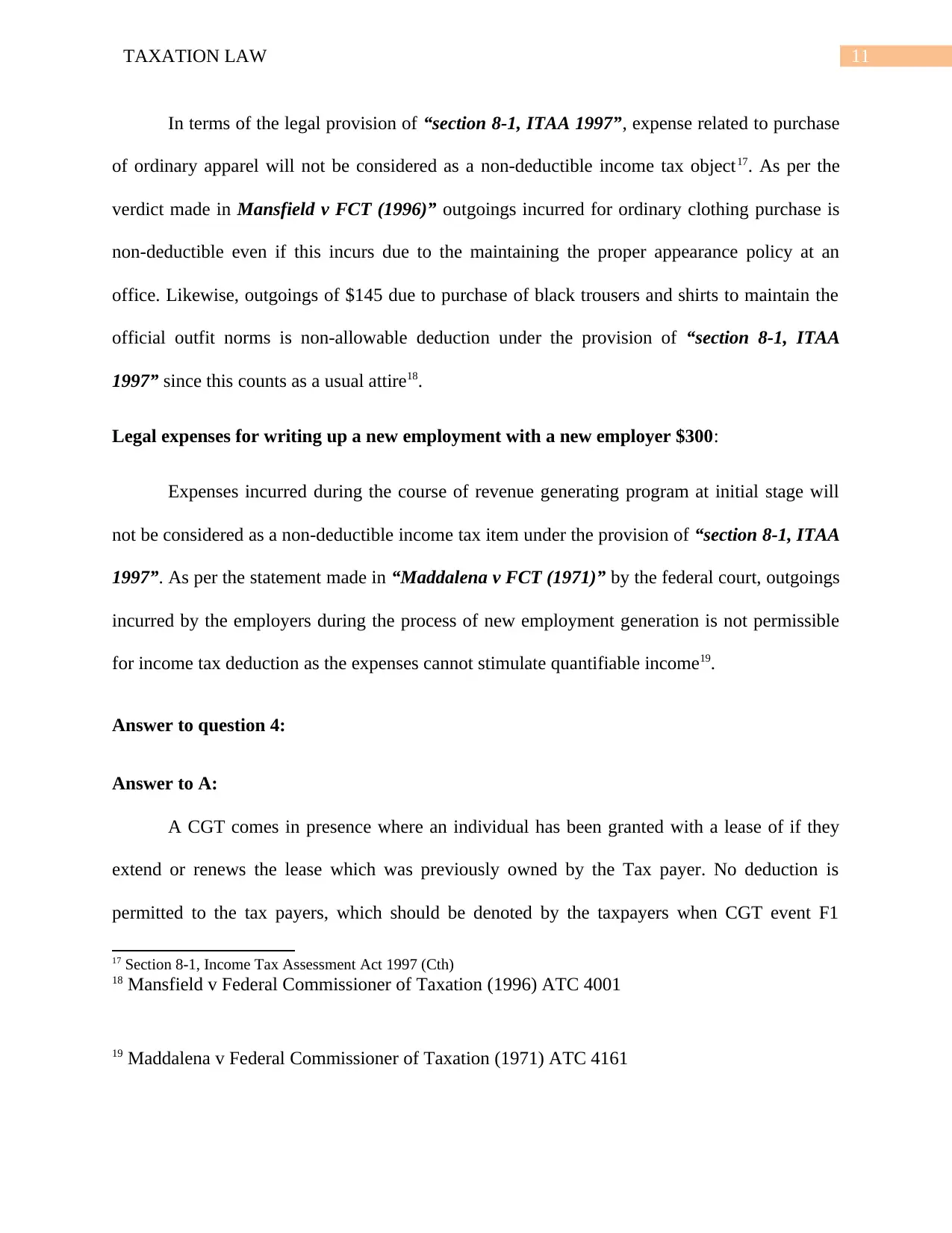
11TAXATION LAW
In terms of the legal provision of “section 8-1, ITAA 1997”, expense related to purchase
of ordinary apparel will not be considered as a non-deductible income tax object17. As per the
verdict made in Mansfield v FCT (1996)” outgoings incurred for ordinary clothing purchase is
non-deductible even if this incurs due to the maintaining the proper appearance policy at an
office. Likewise, outgoings of $145 due to purchase of black trousers and shirts to maintain the
official outfit norms is non-allowable deduction under the provision of “section 8-1, ITAA
1997” since this counts as a usual attire18.
Legal expenses for writing up a new employment with a new employer $300:
Expenses incurred during the course of revenue generating program at initial stage will
not be considered as a non-deductible income tax item under the provision of “section 8-1, ITAA
1997”. As per the statement made in “Maddalena v FCT (1971)” by the federal court, outgoings
incurred by the employers during the process of new employment generation is not permissible
for income tax deduction as the expenses cannot stimulate quantifiable income19.
Answer to question 4:
Answer to A:
A CGT comes in presence where an individual has been granted with a lease of if they
extend or renews the lease which was previously owned by the Tax payer. No deduction is
permitted to the tax payers, which should be denoted by the taxpayers when CGT event F1
17 Section 8-1, Income Tax Assessment Act 1997 (Cth)
18 Mansfield v Federal Commissioner of Taxation (1996) ATC 4001
19 Maddalena v Federal Commissioner of Taxation (1971) ATC 4161
In terms of the legal provision of “section 8-1, ITAA 1997”, expense related to purchase
of ordinary apparel will not be considered as a non-deductible income tax object17. As per the
verdict made in Mansfield v FCT (1996)” outgoings incurred for ordinary clothing purchase is
non-deductible even if this incurs due to the maintaining the proper appearance policy at an
office. Likewise, outgoings of $145 due to purchase of black trousers and shirts to maintain the
official outfit norms is non-allowable deduction under the provision of “section 8-1, ITAA
1997” since this counts as a usual attire18.
Legal expenses for writing up a new employment with a new employer $300:
Expenses incurred during the course of revenue generating program at initial stage will
not be considered as a non-deductible income tax item under the provision of “section 8-1, ITAA
1997”. As per the statement made in “Maddalena v FCT (1971)” by the federal court, outgoings
incurred by the employers during the process of new employment generation is not permissible
for income tax deduction as the expenses cannot stimulate quantifiable income19.
Answer to question 4:
Answer to A:
A CGT comes in presence where an individual has been granted with a lease of if they
extend or renews the lease which was previously owned by the Tax payer. No deduction is
permitted to the tax payers, which should be denoted by the taxpayers when CGT event F1
17 Section 8-1, Income Tax Assessment Act 1997 (Cth)
18 Mansfield v Federal Commissioner of Taxation (1996) ATC 4001
19 Maddalena v Federal Commissioner of Taxation (1971) ATC 4161
⊘ This is a preview!⊘
Do you want full access?
Subscribe today to unlock all pages.

Trusted by 1+ million students worldwide
1 out of 21
Related Documents
Your All-in-One AI-Powered Toolkit for Academic Success.
+13062052269
info@desklib.com
Available 24*7 on WhatsApp / Email
![[object Object]](/_next/static/media/star-bottom.7253800d.svg)
Unlock your academic potential
Copyright © 2020–2025 A2Z Services. All Rights Reserved. Developed and managed by ZUCOL.





